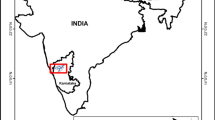Abstract
Highly reliable forecasting of streamflow is essential in many water resources planning and management activities. Recently, least squares support vector machine (LSSVM) method has gained much attention in streamflow forecasting due to its ability to model complex non-linear relationships. However, LSSVM method belongs to black-box models, that is, this method is primarily based on measured data. In this paper, we attempt to improve the performance of LSSVM method from the aspect of data preprocessing by singular spectrum analysis (SSA) and discrete wavelet analysis (DWA). Kharjeguil and Ponel stations from Northern Iran are investigated with monthly streamflow data. The root mean square error (RMSE), mean absolute error (MAE), correlation coefficient (R) and coefficient of efficiency (CE) statistics are used as comparing criteria. The results indicate that both SSA and DWA can significantly improve the performance of forecasting model. However, DWA seems to be superior to SSA and able to estimate peak streamflow values more accurately. Thus, it can be recommended that LSSVM method coupled with DWA is more promising.







Similar content being viewed by others
References
Adamowski J, Chan HF (2011) A wavelet neural network conjunction model for groundwater level forecasting. J Hydrol 407:28–40
Adamowski J, Sun K (2010) Development of a coupled wavelet transform and neural network method for flow forecasting of non-perennial rivers in semi-arid watersheds. J Hydrol 390:85–91
Al-geelani NA, Piah MAM, Shaddad RQ (2012) Characterization of acoustic signals due to surface discharges on H.V. glass insulators using wavelet radial basis function neural networks. Appl Soft Comput 12:1239–11246
Bhagwat PP, Maity R (2012) Multistep-ahead river flow prediction using LS-SVR at daily scale. J Water Resour Prot 4:528–539
Cimen M (2008) Estimation of daily suspended sediments using support vector machines. Hydrolog Sci J 53(3):656–666
Cimen M, Kisi O (2009) Comparison of two different data-driven techniques in modeling lake level fluctuations in Turkey. J Hydrol 378:253–262
Daliakopoulos IN, Coulibaly P, Tsanis IK (2005) Groundwater level forecasting using artificial neural networks. J Hydrol 309:229–240
Demirel MC, Venancio A, Kahya E (2009) Flow forecast by SWAT model and ANN in Pracana basin, Portugal. Adv Eng Softw 40:467–473
Golyandina N, Korobeynikov A (2014) Basic singular spectrum analysis and forecasting with R. Comput Stat Data An 71:934–954
Golyandina N, Nekrutkin V, Zhigljavsky A (2001) Analysis of time series structure: SSA and related techniques. Chapman & Hall/CRC
Hsu KL, Gupta HV, Sorooshian S (1995) Artificial neural network modelling of the rainfall-runoff process. Water Resour Res 31(10):2517–2530
Jaipuria S, Mahapatra SS (2014) An improved demand forecasting method to reduce bullwhip effect in supply chains. Expert Syst Appl 41(5):2395–2408
Ji H, Yucheng B, Huiyuan W (2011) Electromechanical equipment state forecasting based on genetic algorithm-support vector regression. Expert Syst Appl 38:8399–8402
Kalteh AM (2013) Monthly river flow forecasting using artificial neural network and support vector regression models coupled with wavelet transform. Comput Geosci 54:1–8
Kalteh AM (2015) Wavelet genetic algorithm-support vector regression (wavelet GA-SVR) for monthly flow forecasting. Water Resour Manage 29(4):1283–1293
Kalteh AM, Berndtsson R (2007) Interpolating monthly precipitation by self-organizing map (SOM) and multilayer perceptron (MLP). Hydrolog Sci J 52(2):305–317
Kisi O (2012) Modeling discharge-suspended sediment relationship using least square support vector machine. J Hydrol 456–457:110–120
Kisi O (2015) Streamflow forecasting and estimation using least square support vector regression and adaptive neuro-fuzzy embedded fuzzy c-means clustering. Water Resour Manage 29(14):5109–5127
Kisi O, Cimen M (2009) Evapotranspiration modelling using support vector machines. Hydrolog Sci J 54(5):918–928
Kisi O, Cimen M (2011) A wavelet-support vector machine conjunction model for monthly streamflow forecasting. J Hydrol 399:132–140
Kisi O, Dailr AH, Cimen M, Shiri J (2012) Suspended sediment modeling using genetic programming and soft computing techniques. J Hydrol 450–451:48–58
Lin YJ, Cheng CT, Chau KW (2006) Using support vector machines for long-term discharge prediction. Hydrolog Sci J 51(4):599–612
Mallat SG (1989) A theory for multi resolution signal decomposition: the wavelet representation. IEEE T Pattern Anal 11(7):674–693
Mellit A, Pavan AM, Benghanem M (2012) Least squares support vector machine for short-term prediction of meteorological time series. Theor Appl Climatol 111(1–2):297–307
Pai PF (2006) System reliability forecasting by support vector machines with genetic algorithms. Math Comput Model 43(3–4):262–274
Partal T, Kisi O (2007) Wavelet and neuro-fuzzy conjunction model for precipitation forecasting. J Hydrol 342(2):199–212
Rocco SCM (2013) Singular spectrum analysis and forecasting of failure time series. Reliab Eng Syst Safe 114(1):126–136
Samsudin R, Saad P, Shabri A (2011) River flow time series using least squares support vector machines. Hydrol Earth Syst Sc 15:1835–1852
Shabri A, Suhartono (2012) Streamflow forecasting using least-squares support vector machines. Hydrolog Sci J 57(7):1–19
Suykens JAK (2001) Nonlinear modelling and support vector machines. In: Proceeding of IEEE Instrumentation and Measurement Technology Conference 1: 287–294
Suykens JAK, Vandewalle J (1999) Least squares support vector machine classifiers. Neural Process Lett 9(3):293–300
Wang WC, Chau KW, Cheng CT, Qiu L (2009) A comparison of performance of several artificial intelligence methods for forecasting monthly discharge time series. J Hydrol 374:294–306
Wu CL, Chau KW (2011) Rainfall-runoff modeling using artificial neural network coupled with singular spectrum analysis. J Hydrol 399:394–409
Wu CL, Chau KW, Li YS (2008) River stage prediction based on a distributed support vector regression. J Hydrol 358(1–2):96–111
Wu CL, Chau KW, Fan C (2010) Prediction of rainfall time series using modular artificial neural networks coupled with data-preprocessing techniques. J Hydrol 389:146–167
Yoon H, Jun SC, Hyun Y, Bae GO, Lee KK (2011) A comparative study of artificial neural networks and support vector machines for predicting groundwater levels in a coastal aquifer. J Hydrol 396(1–2):128–138
Yu PS, Chen ST, Chang IF (2006) Support vector regression for real-time flood stage forecasting. J Hydrol 328:704–716
Author information
Authors and Affiliations
Corresponding author
Rights and permissions
About this article
Cite this article
Kalteh, A.M. Improving Forecasting Accuracy of Streamflow Time Series Using Least Squares Support Vector Machine Coupled with Data-Preprocessing Techniques. Water Resour Manage 30, 747–766 (2016). https://doi.org/10.1007/s11269-015-1188-3
Received:
Accepted:
Published:
Issue Date:
DOI: https://doi.org/10.1007/s11269-015-1188-3




